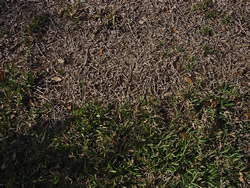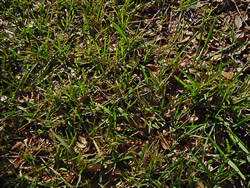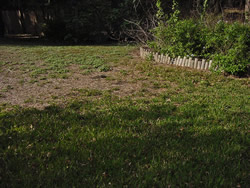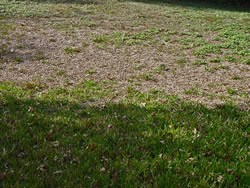Search
For The Answer
Click here to access our database of
Plant Answers
Search
For The Picture
Click here to access the Google database of plants
and insects
Information
Index
Alphabetical Listing of Topics, Recommendations
and Plants
Milberger's Nursery and Landscaping
3920 North Loop 1604 E.
San Antonio, TX 78247
210.497.3760
nursery@milbergersa.com
Open 9 to 6 Mon. through Sat.
and 10 to 5 on Sun.

Three exits east of 281, inside of 1604
Next to the Diamond Shamrock station
Please click map for more detailed map and driving directions.
| DROUGHT DAMAGE AND CITRUS SEARCH Most of the time we are providing you information but now we need your help and are willing to reward you for your participation. This request concerns the condition of the lawn grass after the winter drought and location of any uncommon, exotic citrus in the area.
First we will discuss the grass situation. Most reasonable people
without an obvious "water agenda" have realized and
admitted that the San Antonio-South Texas area, south and west,
have experienced and continue to experience the worse winter drought
in history. Also, many folks are beginning to notice that some
lawn grasses are extremely green We need to know why all of this still-dormant, slow-greening grass is immediately next to fully greened lawns. Of course, common sense would tell us that the folks with the green lawns watered during the winter and the folks with the brown lawns wanted to save money on their sewage fee charges and opted not to water. Yet some of my colleagues are in denial concerning this basic truth of plant growing--ALL LIVING THINGS NEED WATER TO FLOURISH even in the winter when plants are considered to be dormant. In the absence of much information about winter droughts, some unbiased horticulturists in the area have put together what has become the most information ever written about winter droughts. This information along with images to prove the point can be seen at: http://www.plantanswers.com/drought_watering.htm http://www.plantanswers.com/winter_drought_stress.htm http://www.plantanswers.com/watering_trees.htm http://www.plantanswers.com/texas_sized_thirst.htm http://www.plantanswers.com/drought_capital_d.htm http://www.plantanswers.com/rain_event.htm The opposition side to watering during a winter drought is presented http://www.plantanswers.com/special_irrigation.htm http://www.plantanswers.com/to_water_not_to_water.htm It is obvious when reading the opposition columns that these folks are mainly interested in saving as much water as possible to avoid water restrictions AT ANY COST to landscapes and the public who will have to replant the dead and dying plant materials. Water is a resource and should be used when necessary to keep plants healthy--it is why we have water. Water is not supposed to be withheld for those purposes it is intended to be used for. Local horticulturists are still trying to verify why there are
many lawns slowly greening with lots of dead spots of grass immediately
next to fully greened lawns of the same grass type. Of course,
common sense would tell us that the folks with the green lawns
watered during the winter (especially in December and January)
and the folks with the sparse green lawns and lots of dead grass
didn't realize grass needs If you want to telephone your results or relay them to us personally, call the Milberger Nursery Garden Show at 210-308-8867 or toll free: 1-866-308-8867 on Saturday or Sunday from 12:00 p.m. to 2:00 p.m. on KLUP Radio (AM 930) during show hours. We will take your mailing information and send you the free seed. If you want to mail your findings, send a self-addressed, stamped envelop to: Drought Study and Citrus Findings, P. O. Box 380391, San Antonio, Texas 78268-7391. The other way you can get free 'Daily BM' seed is to help us
locate any uncommon, exotic citrus in the area. You realize Drs.
Larry Stein and Jerry Parsons have introduced several new satsuma
mandarin orange varieties to Texas in the last 10 years. They
have even created a very informative website about growing Patio
Citrus at: So now WE need YOUR help to educate the common-senseless water
purveyors and to find a new and wonderful citrus for all to enjoy. |







